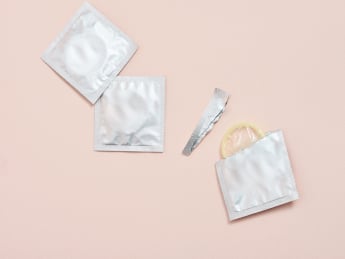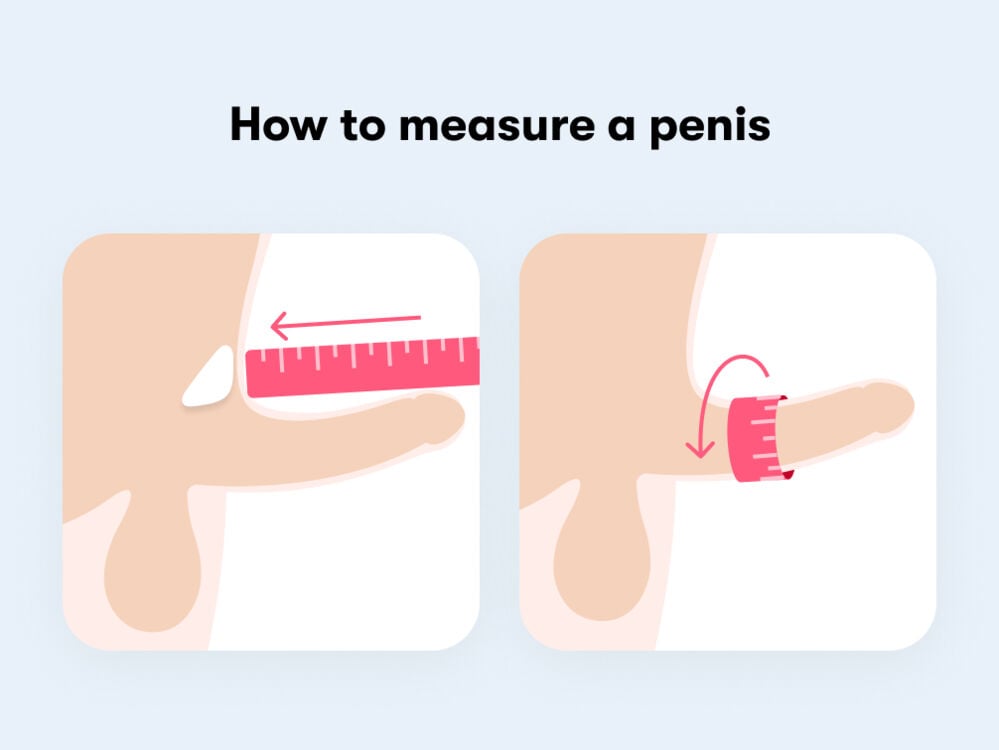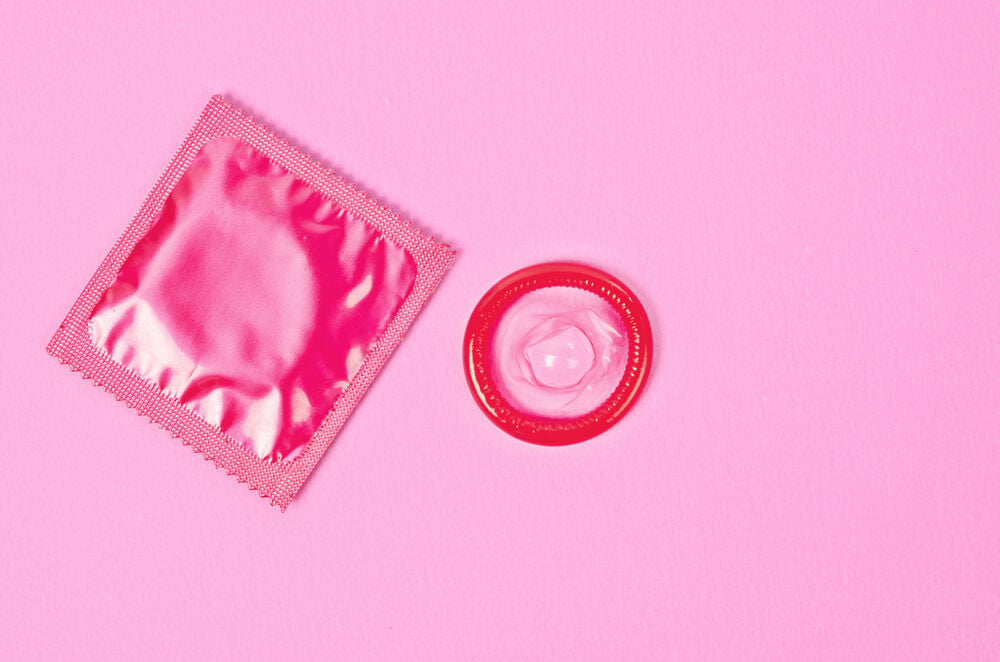Condoms make sex safer, but did you know they come in different sizes? Getting the right fit is so important, so read our condom sizing guide before you buy.
-
Tracking cycle
-
Getting pregnant
-
Pregnancy
-
Help Center
-
Flo for Partners
-
Anonymous Mode
-
Flo app reviews
-
Flo Premium New
-
Secret Chats New
-
Symptom Checker New
-
Your cycle
-
Health 360°
-
Getting pregnant
-
Pregnancy
-
Being a mom
-
LGBTQ+
-
Quizzes
-
Ovulation calculator
-
hCG calculator
-
Pregnancy test calculator
-
Menstrual cycle calculator
-
Period calculator
-
Implantation calculator
-
Pregnancy weeks to months calculator
-
Pregnancy due date calculator
-
IVF and FET due date calculator
-
Due date calculator by ultrasound
-
Medical Affairs
-
Science & Research
-
Pass It On Project New
-
Privacy Portal
-
Press Center
-
Flo Accuracy
-
Careers
-
Contact Us
How condom sizes work and why fit is important


Every piece of content at Flo Health adheres to the highest editorial standards for language, style, and medical accuracy. To learn what we do to deliver the best health and lifestyle insights to you, check out our content review principles.
We don’t need to tell you that using a condom is one of the best ways to practice safer sex.
Not only do condoms help protect you from unplanned pregnancy if you’re having penis-in-vagina sex, but when used correctly, they’re also one of the only forms of birth control that will keep you safe from sexually transmitted infections (STIs), whatever sex you’re having. (Just a note: This article will focus on male or external condom sizing, but you can find information about internal condoms in our guide to safer LGBTQ+ sex here.)
Lots of people also prefer condoms to long-acting reversible contraception, such as the implant or an IUD, because they’re non-hormonal and only need to be used in the moment.
But did you know male condoms are available in three different sizes: snug, regular, and large? And fit really matters? Let’s deep dive into condom sizing so you know what to buy.
Why condom size matters
Although selecting the right size of condom might not seem like a priority when you’re ordering online or stocking up at the supermarket or pharmacy, fit is actually really important.
In order for a condom to do its job properly, it needs to be the right size. Condoms that are too loose are more likely to slip off during sex, while condoms that are too tight could break more easily. That puts you at a greater risk of unplanned pregnancy or STIs.
How condom sizes work
So, you know you and your partner need a condom, but how are you supposed to know what size condom to buy?
The only real way to figure out what condom size you need is to measure your partner’s penis when it’s erect, which might seem a little embarrassing or strange to begin with, but remember the outcome is going to help keep you both protected from STIs and unplanned pregnancies.
Penises come in all different shapes and sizes, so there are two important measurements to take into account when it comes to condom sizing: girth and length.
Take a quiz
Find out what you can do with our Health Assistant
- Length: Hold a ruler against the pubic bone (find it at the front of the pelvis) while erect and measure from the base to the tip of the penis.
- Girth: Take a flexible measuring tape and measure around the thickest portion of the erect penis. If you don’t have a flexible measuring tape, wrap a piece of string around the penis. Mark the spot where the string crosses, and then measure the length of the string with a ruler.
You could also try an online condom size calculator. These calculators provide a general condom size guide and can determine exactly which types of condoms will fit best. Many of these calculators can even recommend specific condoms according to your ideal condom size.

What’s the average penis size?
You’ve probably heard that the average erect penis length is around 6 inches. But a recent study has challenged this widely held wisdom.
Researchers at the Department of Psychology at Clemson University in the US looked at the combined mean of 10 studies where penis length measurements were taken by health professionals rather than the participants themselves. They found that the average penis was actually 5.1 to 5.5 inches long (usually at the lower end), rather than the average 6-inch measurement that men self-reported in previous studies. Social desirability bias could have influenced the earlier results, the experts concluded.
We also know that the average penis circumference is 11.66 centimeters or 4.5 inches, thanks to a British study that measured the flaccid and erect penises of 15,521 men.
That said, all penises are slightly different so it’s important to measure your partner’s penis carefully before buying condoms.

Condom sizes chart
Once you and your partner have the right measurements, you can use them to work out which size condom to buy and use. There are three different sizes of condoms, and you can buy them from supermarkets, pharmacies, sex shops, or online. Remember that condom sizes can vary from brand to brand, so check their websites for the latest information.
- Snug fit condoms
Condoms labeled “snug fit” are best for a penis that is shorter than the average length of 5.1 to 5.5 inches (13 to 14 centimeters) and girth of 4.5 inches (around 12 centimeters) when erect.
- Regular fit condoms
Most condoms are made for the average size range (above) and are labeled “regular fit.” Snug condoms can be used for added sensation and pleasure if the penis is on the shorter end of average but if your partner says it feels too tight, it’s better to stick to regular ones.
- Large condoms
Large condoms are usually around 7.5 to 8.5 inches (19 to 21.5 centimeters) long and are appropriate for penises that are above-average length.
Other things to consider when buying condoms
Once you and your partner have worked out what size condom you need, there are a few other factors to consider, including the material of the condom, wheather it’s lubricated, and if there’s anything additional that can affect how pleasurable sex is for you. For example, some people prefer the sensation of ribbed condoms, while others might like flavored condoms for use during oral sex.

Choosing birth control (18+)
Get answers to the most common questions, chat with our friendly chatbot and join other people around the world in secret chats.
Material
Most condoms are made of thin latex that provides an effective barrier against even the smallest pathogens. This works for most people, but if you or your partner are allergic to latex, you’ll need to find a different material. Other materials condoms are made from include:
- Polyurethane: These are thinner and conduct heat better, so they’re a popular choice for people who like to feel an increased sensation.
- Lambskin: These are made from a membrane found in sheep’s intestines. They are super thin, so they don’t provide protection from STIs, which is why they should only be used by people who are certain of their STI status and want to prevent pregnancy.
- Polyisoprene: This is similar to latex, but it doesn’t contain the chemical compounds that cause an allergic reaction in some people.
Lubrication
Many condoms are pre-lubricated and some even produce additional sensations, such as heat or cold. Just steer clear of oil–based lubricants if you’re using latex condoms, because the oil can degrade the latex and lead to condom breakage. Choose silicone or water–based lubricants instead.
Thickness, texture, and shape
Thinner condoms usually increase sensitivity during sex because the sensation is more intense. Some condoms come with textured surfaces and shapes that are designed to increase pleasure for you both.
Whatever your preference, just be sure to buy condoms from a reputable brand that prioritizes both effectiveness and pleasure. That way you can have satisfying sex knowing you’re protected.
Condom sizes: The takeaway
Condoms are the best way to protect yourself against both STIs and pregnancy, but a condom needs to be a good fit in order to make sure it’s going to be as effective as possible.
Thankfully, condom sizing is relatively easy to figure out once you have some measurements. After that, you can experiment with materials and textures to have a really positive sex experience with your partner.


Hey, I'm Anique
I started using Flo app to track my period and ovulation because we wanted to have a baby.


The Flo app helped me learn about my body and spot ovulation signs during our conception journey.


I vividly
remember the day
that we switched
Flo into
Pregnancy Mode — it was
such a special
moment.
Real stories, real results
Learn how the Flo app became an amazing cheerleader for us on our conception journey.
References
“Condom Size Chart With Snug, Regular and Large Size Condoms.” Condom-Sizes.Org, 23 Dec. 2021, www.condom-sizes.org/condom-size-chart/condom-size-chart. Accessed 11 Feb. 2022.
“Average-Size Erect Penis: Fiction, Fact, and the Need for Counseling.” Taylor & Francis, www.tandfonline.com/doi/full/10.1080/0092623X.2020.1787279. Accessed 17 Feb. 2022.
Veale, David. “Am I Normal? A Systematic Review and Construction of Nomograms for Flaccid and Erect Penis Length and Circumference.” BJU International, 1 June 2015, bjui-journals.onlinelibrary.wiley.com/doi/10.1111/bju.13010. Accessed 17 Feb. 2022.
“NCBI: Feasibility Study of the Home-Based Exercises for Responsible Sex (HERS) Intervention to Promote Correct and Consistent Condom Use among Young Women.” NCBI, www.ncbi.nlm.nih.gov/labs/pmc/articles/PMC8314454. Accessed 17 Feb. 2022.
“NCBI: Condoms.” NCBI, www.ncbi.nlm.nih.gov/books/NBK470385. Accessed 17 Feb. 2022.
“Sage Journals: The Impact of Lubricants on Latex Condoms during Vaginal Intercourse.” Sage Journals, journals.sagepub.com/doi/10.1177/095646249400500108. Accessed 17 Feb. 2022.
“12 Common Mistakes When Using Condoms –.” Brook, www.brook.org.uk/your-life/condoms-common-mistakes. Accessed 11 Feb. 2022.
WHO, UNAIDS. “The Male Latex Condom, Fact Sheet.” UNAIDS, data.unaids.org/publications/irc-pub01/jc003-malecondom-factsheets_en.pdf. Accessed 11 Feb. 2022.




